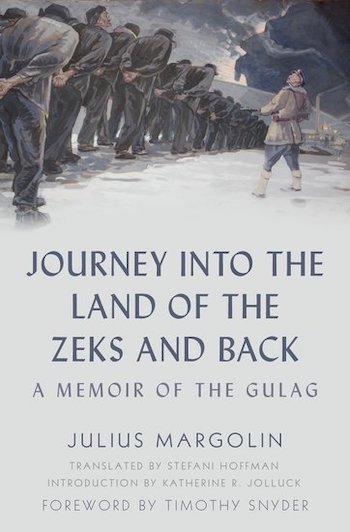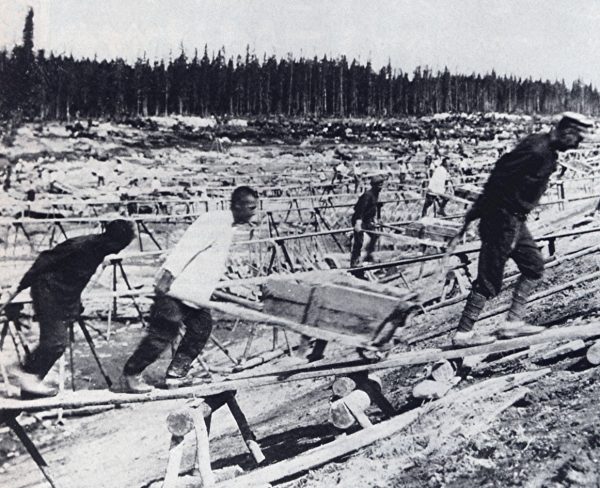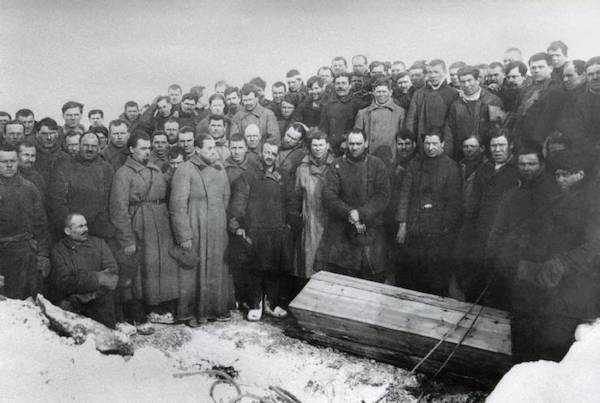Book Review: “Journey into the Land of the Zeks and Back” — “Jews, Write and Record.”
By Harry Merritt
An unabridged text of an incisive, harrowing, and absorbing eyewitness account of the Gulag has finally been published in English translation.
Journey into the Land of the Zeks and Back: A Memoir of the Gulag by Julius Margolin. Translated by Stefani Hoffman. Foreword by Timothy Snyder and Introduction by Katherine R. Jolluck. Oxford University Press, 648 pages, $39.95.
Go here to buy at Bookshop

On September 3, 1939, Julius Margolin was scheduled to leave his old home, Łódź, Poland, for his new home, Tel Aviv, in the British Mandate of Palestine. But Nazi Germany invaded Poland on September 1 and that initiated a seven-year odyssey covering thousands of miles across Poland and Russia. Margolin successfully escaped the advancing Nazi forces, only to end up under a Soviet occupation that sought to dismantle his former homeland and its institutions while denying him the right to return to his new homeland. Together with countless other Polish citizens who now constituted “socially dangerous elements” in the eyes of the Soviet authorities, Margolin was tossed into the system of Soviet “corrective labor camps” known as the Gulag. Against all odds, he completed his five-year sentence of hard labor, returning first to Poland and then to Palestine, completing this book in 1947. Now, over 70 years later, the unabridged text — an incisive, harrowing, and absorbing eyewitness account of the Gulag — has finally been published in English translation.
Margolin’s transformation from “a free man of the West” into a zek, derived from the Russian word zakliuchënnyi (“prisoner,” from the abbreviation z/k), was gradual. He notes that when the Soviet Union’s Red Army first entered Poland on September 17 broad swaths of the Polish population greeted the troops with enthusiasm. Polish Jews, like Margolin, had good reason to fear Nazism more than Communism (today they are scorned by many in Poland because of their alleged warm welcome of the Red Army). Belarusians and Ukrainians were also cautiously optimistic about uniting with their co-nationals across the Soviet border. Many ethnic Poles hoped that the Red Army had arrived to beat back the German Wehrmacht. Such dreams were quickly dashed. A Revisionist Zionist, Margolin never had to grapple with the disillusionment of those on the political left once they encountered the realities of Soviet rule. But even he asked himself whether half a million people could be imprisoned in the course of Sovietization (the real number eventually deported from Eastern Poland was nearly three times that figure). The gradual atomization of Polish society under Soviet rule, “the common person’s…strategy of retreat…into the fortress of his private existence,” has been chronicled in the work of historians like Jan Gross, but it is vividly portrayed in Journey into the Land of the Zeks and Back.
The regime finally trapped the resourceful Margolin, though it took months. He managed to escape by navigating the Soviet bureaucracy, accepting odd jobs, drawing on his mastery of multiple languages as well as his skills in cleverly exploiting the rhetoric of the Communist Party for his own benefit. When the Soviet secret police, the NKVD, interrogated Margolin — because of his refusal to accept a Soviet passport and his repeated attempts to secure an exit visa for Palestine — his old mode of thinking “in categories of European justice” clashed with the realization that “being ‘alien’ in Soviet conditions is a crime.” He refused Soviet citizenship, yet Margolin and others were still charged with failing in their civic duties to the Soviet Union. The verdict came before the interrogation; the sentence did not arrive until Margolin had already been moved a thousand miles away from his residence in Poland to a camp in the Russian subarctic.
Representatives of the Soviet security forces and penal administration reacted with amusement and astonishment to Margolin’s PhD. Some concluded that, as a “highly cultured person,” he could be valuable to the Soviet state. But Margolin quickly realized he has been put in the Gulag to provide slave labor for the state. He was defined by the cumbersome but evocative word rabguzhsila (“man/horsepower”). One’s labor determined one’s food ration and therefore one’s survival. Those in the lowest ration tiers were doomed to starvation. One day, while carrying buckets of water over his shoulders, Margolin realized that he had been transformed from an intellectual into the image of Herschel, “the very personification of Jewish poverty” in his hometown. Margolin ignored Soviet slogans meant to inspire so-called “shock workers” to perform heroic feats of labor. Still, he wanted to prove himself worthy of doing hard labor in the field, even though his body was not up to the task. Gulag labor gradually wore him down: at first, other inmates referred to the 40-year-old Margolin as “dad.” Then it became “grandpa.”
In the camp, morality and reason were also completely inverted. There were nominal concessions to humaneness and rehabilitation: a medical sector to treat sick inmates, a cultural-educational section, and even (absurdly) a complaint box where one could deposit “complaints and petitions to the Commander of the camp, the Presidium of the Supreme Soviet, or the Chief Prosecutor of the USSR.” The camp’s social hierarchy mirrored that of Soviet society, a pecking-order set up to isolate individuals, to pit them against one another. Even the use of the pronoun “we” threatened Soviet authorities. Though the camps were ostensibly secure facilities under constant armed guard, Margolin and his fellow zeks were at the mercy of the urki, the hardened criminals who preyed on their fellow prisoners. A zek’s possessions and food were always at risk. A physically unimposing Westerner with exotic possessions in tow, Margolin became a prime target for the urki. When he finally retaliated violently against one of his tormentors, it did not bring satisfaction. He felt only that he had gone through “another stage of dehumanization.” Margolin concluded that one could only leave the camp a “spiritual cripple” or a psychopath.

The White Sea–Baltic Canal opened on August 2, 1933. It was the first major industrial project constructed in the Soviet Union using only forced labor. Margolin was originally sent to a camp affiliated with the White Sea-Baltic Canal. Photo: Wiki Commons.
Margolin’s experience is at heart a story of the borderlands of Central and Eastern Europe, which were transformed during the middle of the 20th century from a multireligious, multiethnic periphery of empires to a series of homogenous nation-states. The tremendous violence that was needed to reshape this region has produced such retrospective labels as “bloodlands,” coined by the historian Timothy Snyder, who contributed a foreword to the book. At the start of the war, the majority of the world’s Jews lived in these borderlands, a legacy of centuries of Jewish migration and the Pale of Jewish Settlement in the Russian Empire. Jewish refugees like Margolin not only had to flee the exterminatory anti-Semitism of Nazi Germany, but also faced the lethal indifference of other European states. At various points, officials at the Romanian border, in the British consulate in Moscow, and in the Polish government-in-exile blocked Margolin’s escape. They were unwilling to grant refuge to a Jew. Deception became a survival strategy in the borderlands; it could mean blending in with gentiles, passing as a different ethnicity, or concealing one’s past political affiliations or social origins. Ironically, the simmering conflict between Catholic Poles and Polish Jews reached a temporary truce in the Gulag. They all became “Westerners,” united by a common culture, language, and shared experience of alienation. Soviet Jews practiced rusty Yiddish with the “Westerners,” reconnecting across a border created between them two decades prior. When he was treated by a kindly Arab camp doctor who spoke fondly with him about Palestine, Margolin exclaimed, “Here was a place where, finally, Arabs and Jews were friends.”
Margolin saw the Gulag as another country, an incomprehensible land with a strange morality and alien customs. Once there, its inmates “departed from human memory, from history.” Thankfully, he recounts compelling stories of the numerous people he encountered in this new world, rescuing them from history’s dustbin. There is Met, a self-identified Jewish thief whose character was reminiscent of Jaroslav Hašek’s Good Soldier Švejk. The man’s open praise of Hitler and animalistic resistance to punishment overawed the camp authorities. Simple acts, like a young woman’s unpremeditated sharing of bread with Margolin, touched him deeply. Such humane moments were rare in the Gulag, but they “radiate energy and an unceasing light that shines for years in the depths of our being.” Margolin questioned the idea of “Man” but believed that the lives of the men he encountered deserved to be remembered. Indeed, these stories demonstrate that the camp inmates were never fully divided or completely demoralized.

A funeral attended by miners in a Russian gulag. Photo: Wiki Commons.
Implicitly, the comparison for Margolin, as it has been for many, is between the Gulag and Nazi Germany’s own system of camps, known by their own abbreviation, KZ, for Konzentrationslager. He distinguished between the two systems, but sharply denounces the temptations of lesser evilism: “Do not justify Soviet camps by asserting that Auschwitz, Majdanek, and Treblinka were much worse.” The Nazi regime dehumanized its victims, but Margolin regards this as a transitory aberration in the history of Europe. In contrast, he believed that the systematic hatred he experienced in the Soviet Union was both icy and deeply embedded in modernity. Converging in interesting ways with the Holocaust studies of Hannah Arendt and Zygmunt Bauman, Margolin notes that the waves of Soviet deportation, mass incarceration, and murder constituted “a violent, monstrous but completely objective murderous force,” carried out “indifferently, calmly, and with bureaucratic dispassion.”
Less compelling are Margolin’s characterization of Russians as “semi-savage” “Eurasians” who adopted the worst elements from European and Asian cultures. But his descriptions call to mind another Jewish writer who compared and contrasted the Soviet Union and Nazi Germany, Vasily Grossman, who pontificated on Russia’s “slave soul” in his novel Everything Flows. This juxtaposition — between the German Gestapo (“Secret State Police”) and Soviet “Mustapo” (“wise Stalinist policy”) — posits that Jews from the borderlands faced either “physical death” at the hands of the Germans or “moral death” at the hands of the Soviets. Margolin’s impassioned analysis carries great moral weight, but it should not be the only takeaway for American readers.
Margolin published his text to challenge rosy postwar Western perceptions of the Soviet Union: “The world knows everything about Stalingrad but nothing about the camps.” That was true at the time, but awareness of the Gulag has increased considerably since the 1974 release of Aleksandr Solzhenitsyn’s The Gulag Archipelago. But those who read Margolin’s text as just another critique of Nazi-Soviet totalitarianism do so at their peril. To find a contemporary version of corrective labor camps, its vast prison population weakened by an epidemic disease and sent out to perform dangerous work on behalf of the state for a pittance, one need only look at California. Over the summer, the California Department of Corrections and Rehabilitation faced a deep crisis — it needed its incarcerated firefighters to battle wildfires of unprecedented scale and strength. But the prison labor force had been crippled by major outbreaks of COVID-19, reaching 14,000 cases and 65 deaths by October 2020. Until last month, these incarcerated firefighters have been forbidden from pursuing the same work upon release, a restriction that reflects the kind of post-release marginalization and recidivism characteristic of the Gulag. California’s prison labor system, as in many other parts of the US, continues principles behind convict leasing. This system, established in the aftermath of the Civil War and maintained in several Southern US states until the ’20s, proved particularly lethal for its largely African American prison labor force. Margolin’s memoir also has much to say about the plight of refugees and stateless persons who flee war and persecution, only to be condemned by bureaucracy and indifference.
In 1939, “an avalanche of human grief” descended on Europe. The sheer enormity of the death, displacement, and destruction makes many turn to examining statistics rather than individual stories. Journey into the Land of the Zeks and Back acknowledges the scale of the catastrophe, but the volume focuses on its impact on humanity. In 1941, in the Riga Ghetto in German-occupied Latvia, historian Simon Dubnow instructed those around him, “Jews, write and record.” Margolin not only managed to record his own fascinating story, but those of other Gulag inmates, buried in anonymous graves in the far reaches of Russia.
Harry C. Merritt is a Lecturer in the Department of History at Boston University, researching the social impact of war on the borderlands of modern Eastern Europe. He has also contributed to Jacobin and The Awl. For more, see his website.

A fine review of what appears to be an exceptional and long-overdue book.
An exceptionally well-written and well-framed review of what appears to be a most compelling book, an important pendant and complement to The Gulag Archipelago, read by this writer decades ago.